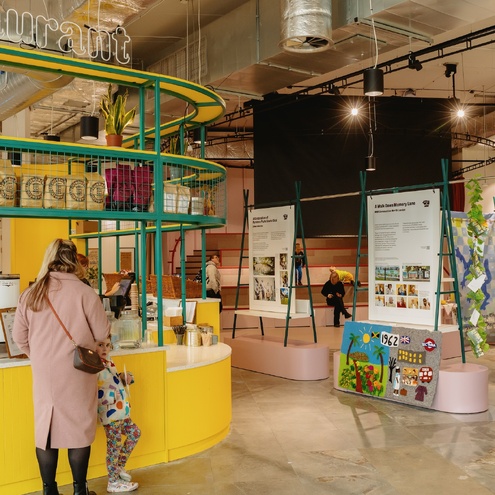Get updates from The Developer straight to your inbox Yes, please!
The Dugdale Arts Centre, Enfield – London Borough of Enfield with Dallas-Pierce-Quintero

Born out of meanwhile activation spaces due to the pandemic and the Build-the-Change initiative, the retrofit for The Dugdale Arts Centre is designed to be adaptable and welcoming. Home to the Museum of Enfield, the Black Box theatre and a new cafe, the space is culturally valuable and inclusive, with work spaces and a number of clubs running activities.
Who is on the project team?
Contractor: Willmott Dixon Interiors
Collaborators:
TP Bennett Architects (architects on the rest of the Thomas Hardy House refurb)
Graphic Design: Stephen Barrett
Sound Design: Coda to Coda
Service Engineer: Pick Everard
QS: Stace
MEP Engineer: Bancroft Blue
Describe the context of this project?
Enfield is a diverse borough of contrasts – urban and natural environments, wealth and deprivation – and is undergoing significant regeneration. In 2020, D-P-Q were appointed by Enfield Council to develop a borough-wide cultural strategy, tying into their pre-existing Build the Change initiative. Reinforced through the pandemic, this strategy highlighted culture as a key tool to connect communities together, by forging opportunities for people of all ages and backgrounds.
The existing Dugdale was central to this strategy, as Enfield’s cultural hub. Located within Thomas Hardy House at the gateway to Enfield Town, this featured a café and theatre, as well as a museum, archives and meeting rooms on the first floor.
Post-pandemic, the Build-the-Change initiative prompted the reorganisation of Council assets for improved efficiencies. This led to the redevelopment of the Dugdale into the dedicated DAC and moved all community cultural provisions to the ground floor, including the museum, for which D-P-Q were commissioned to develop a standalone design.
Tell us what you did and how the project enlivened the place?
DAC seeks to create an inclusive, accessible environment that brings Enfield’s diverse communities and their interest together and offers many Culture Palace tenants a permanent home.
This includes Enfood Café - key to DAC’s business case – whose highly-visible ground-floor presence creates space for visitors to catch-up over coffee, or bring a laptop for homework. In the evening it transforms into a full restaurant thanks to a flexible, commercial kitchen and moveable furniture. This new offering has activated the area’s night-time economy and enhances the appeal of the adjoining black-box theatre. Its profits are reinvested back into community performances and events at DAC, to help expand cultural programming.
To support this, DAC introduces tiered seating, where a retractable curtain and projector offers flexibility for relaxed performances or screenings. A comfortable lounge area acts as a meeting point, that can also be zoned off with curtains, creating a private yet relaxed gathering space, ideal for small groups like mothers and babies.
The interior has been creatively reconfigured to focus on flexibility. DAC uses curtains and floor-zoning to define its programme, preserving the ability to adapt or interlink spaces in the short and long-term. Wide, multiuse tables are easily relocated for different activities, while a modular design for temporary displays allows these be adapted for different exhibition formats. To ease the logistics of the permanent museum’s move, the existing display cases have been repurposed, with cabinetry built around these. The versatile tiered seating also adapts to broader interests needs as it doubles as a stage, with an AV room and deliveries route concealed behind.
Did the project make a positive social and environmental contribution?
In its first month, DAC’s success as a welcoming, democratic hub has been demonstrated by its popularity with residents and visitors alike and will now be measured using visitor counting. By promoting cross-pollination of uses, DAC has helped to bring people of all backgrounds together. Given current economic difficulties, this has proved invaluable in combatting loneliness in the elderly and supporting young people with their well-being.
Furthermore, DAC has renewed pride in local talent, from the museum’s opening exhibit ‘Stories of Enfield’ to the community display case and local craftspeople’s role in fabricating DAC’s furniture and joinery.
The retrofit of the existing ground-floor space has been central to reducing DAC’s carbon footprint. Much of the building was retained and repurposed, from its structure and glazing to the flooring and display cabinets, and heating and ventilation services were adapted to efficiently serve the new layout. The aim is measure sustainability metrics from opening, to monitor and evaluate these environmental strategies.
Sign up to our newsletter
Get updates from The Developer straight to your inbox
Thanks to our organisation members
© Festival of Place - Tweak Ltd., 124 City Road, London, EC1V 2NX. Tel: 020 3326 7238